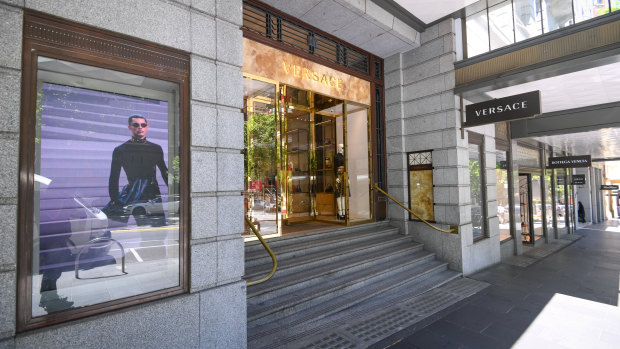After years of rapid growth, Gucci, Louis Vuitton and other luxury purveyors in Australia appear to be flatlining, finally caught up in the cost-of-living crisis confronting the nation’s shoppers.
The world’s top luxury players have been hit by a global sales slump.
Luxury giant LVMH, owner of Louis Vuitton, Dior, Tiffany and Moet & Chandon, surprised global investors last month by reporting a 3 per cent quarterly drop in revenue for its fashion and leather goods, the first since the pandemic.

Stroll down Collins Street and many luxury flagships are devoid of customers even on busy lunchtime workdays.Credit: Justin McManus
Rival luxe conglomerate Kering Group, owner of Gucci, followed up with a profit warning after its sales plunged 16 per cent, fuelling fears of a recession in the sector.
LVMH’s wobbles are focused on Asia, particularly China, where consumers and authorities are battling an extended slowdown. The luxury house, majority-owned by Bernard Arnault, whose wealth has tumbled from first to fifth on the Bloomberg Billionaires Index, reported large falls in the region (excluding Japan) over each of the previous three quarters, culminating in a 16 per cent crunch in September.
The great luxury houses don’t break down sales by individual countries, making it difficult to determine how their glittering Australian emporiums, dotted along Sydney’s King and Castlereagh streets, Perth’s Murray Street and Melbourne’s Collins Street, are performing.
But recent strolls along Collins Street reveal many luxury flagships are devoid of customers even on busy lunchtime workdays.
The cost-of-living crisis, which has plagued retailers over the past few years, now appears to be slowing more well-heeled customers.
Garland & Garland fashion industry adviser Phoebes Garland said shoppers are waiting for discounts and spending less on discretionary items while splashing more on experiences such as travel and concerts.
“There’s an argument to say that these luxury players have become too accessible. You go into every single major shopping precinct around the world and there’s the same shops everywhere,” she said.
However, Brian Walker from the Retail Doctor Group said although trade in Sydney’s luxury outlets may have slowed, it was not substantial. They were still well-supported by tourists and affluent harbour dwellers, he said. “When the majority of Australia feels the cost-of-living crisis, if you liken that to a cold, well, the luxury market gets a bit of a sniffle, but nothing profound.”
Figures supplied to this masthead by global research firm IBISWorld show compounding revenue growth in Australia’s luxury retailing sector has shrunk from a yearly average above 5 per cent (since 2019) to just 0.8 per cent this year, putting an end to a period of turbocharged growth.
LVMH’s Australian revenue grew a remarkable 15 per cent year-on-year between 2019 and 2023, according to IBISWorld, but was trending down last year. Growth also contracted at Chanel, Prada and Richemont, the data shows.
The research firm said while Melbourne and Sydney are popular choices for luxury retailers, rising incomes in Brisbane and Perth are attracting brands such as Gucci, Chanel and Hermes.

The great luxury houses don’t break down sales by individual countries, making it difficult to determine how their glittering Australian emporiums are performing.Credit: Justin McManus
Jim Tsagalis, managing director of Perth estate agency Lease Equity, said luxury brands were still jockeying for position in the city’s premium Murray Street.
“Definitely, there’s been a slowdown in sales, which, in turn, has had an impact on luxury retailing and their expansion,” Tsagalis said.
However, most top-tier brands have already set up in the city, and those that haven’t are expecting to soon. Australian luxury pearl purveyor Paspaley has bought a site, Dior is fitting out a flagship store, and Omega will open its doors next year, he said.
No new luxury leasing deals of note have been signed this year in Melbourne’s Collins Street.
But Cartier, Hermes and Vacheron Constantin have all renewed leases and are in various stages of occupying, expanding and refurbishing their stores, said Ainsworth Property retail specialist Zelman Ainsworth.
“The global trend seems to be adjusting to the rapid expansion, resulting in fewer major deals, although here in the Melbourne CBD, many leasing deals [will] expire in 2026 and 2027, forcing retail groups to re-access their retail networks and plans,” Ainsworth said.
Jostling for the best real estate is also happening in Melbourne.
Chanel paid a thumping $75 million this year to buy the building housing its 10-year-old boutique, where it retails $10,000-plus handbags and shoes. Across the street, LVMH has plunged $39 million into 145-149 Flinders Lane, a five-level beaux arts-style building, earmarking it for a Dior store.
The Market Recap newsletter is a wrap of the day’s trading. Get it each weekday afternoon.